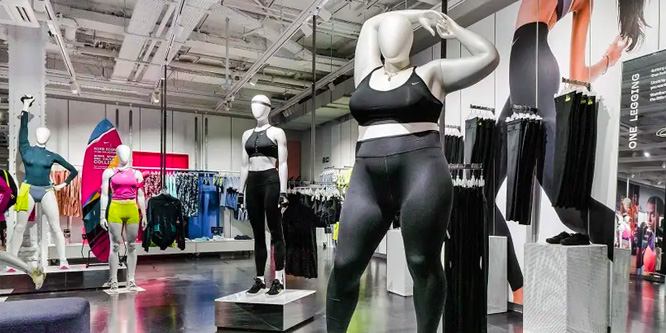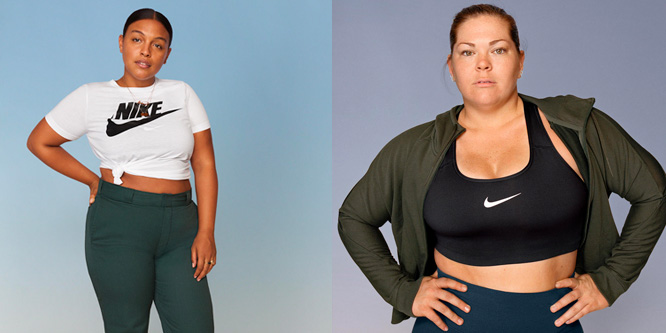
Photo: Nike
Who still thinks one-size-fits-all mannequins make sense?
Nike earned wide praise last week for installing its first plus-size mannequin in one of its stores. The mannequins are featured on a special floor dedicated to women at its refurbished flagship in London.
“To celebrate the diversity and inclusivity of sport, the space will not just celebrate local elite and grassroot athletes through visual content, but also show Nike plus size and para-sport mannequins for the first time on a retail space,” Nike said in a press release.
Nike introduced its first “plus-size” collection in 2017 with sizes ranging from a 1X to 3X.
Consumers took to social media to applaud Nike for embracing diverse body types. In 2014, The Guardian reported that the average mannequin is six-feet-tall with a 34-inch bust, 24-inch waist and 34-inch hips.
Among the social media comments:
- “Idk why but this @Nike mannequin makes me feel so empowered”
- “@nikesportswear @nike got it right!! This mannequin look just like me and you!! Thank you for displaying real bodies in workout gear! Just because we are curvy doesn’t mean we are lazy!”
- “Hopefully, other stores + brands learn from this excellent example and start to use a variety of realistic-sized mannequins.”
Nordstrom, Old Navy and Target have also displayed plus-size mannequins over the last year in support bigger pushes into plus-sized apparel.

From a marketing standpoint, many brands and retailers have been embracing “body positivity” messages — from Dove’s “Real Beauty” campaign that was first introduced in 2004 to CVS’s commitment announced last year to no longer retouch beauty ads. Newer intimates clothing brands, such as Aerie, Third Love and Adore, have earned praise for featuring everyday women in advertising instead of models.
The body positive movement has exploded in recent years with the rise of plus-sized models and social media influencers.
The common knock from critics is that the body positive movement overlooks the health risks of being overweight. Past articles exploring the use of plus-sized models and mannequins have also related that many retail merchants have an ingrained mentality that apparel in smaller sizes looks more appealing.
- Nike Introduces Plus-Size Mannequins In London Store – CNN
- Nike introduces mannequins of all shapes, sizes and abilities in new store – Today
- Nike Just Introduced Curvy Mannequins – People
- What Is REI Doing About Extended Sizing In 2019? – REI
- The Problem With Body Positivity – The New York Times
- Body positivity is everywhere, but is it for everyone? – USA Today
- Nike introduces plus-size mannequins to London store – CNN
- Do thinner mannequins make people buy clothes? – The Guardian
- Plus-Size Mannequin Sparks Outrage For ‘Encouraging Obesity’ – ABC News
- Mannequins get too real for retail – RetailWire
Discussion Questions
DISCUSSION QUESTIONS: Why has it taken so long for plus-sized mannequins to make it to retail selling floors? Do you think plus-sized mannequins will become common over the next five years?


I think it is incredibly empowering for people to see themselves in theater, music, stores without it having to be niched — oh this is a plus-size store, etc. All positive.
Historically, retailers and brands have been in the business of selling aspirations – not what we look like, but what we want to look like. Advertising messages and mannequins reflected this. However, the body positive movement is starting to change that and we’re seeing it everywhere including in mannequins. I think it’s a healthy and positive step for brands/retailers to acknowledge and reflect the reality of human form. I believe the body positive movement will continue to build over the coming years and that’s a good thing.
Kudos to Nike and all that are installing plus-sized mannequins. The International Journal of Fashion Design published a study stating that the average American woman wears between a Misses size 16–18 clothing. That needs to be reflected in-stores if retailers really expect shoppers to feel a connection to them. Creating displays of utopian ideals like was done in the 1950s does not resonate with many people in this era.
Additionally, a mix of mannequins of all sizes/shapes and when appropriate, ethnicities, sends an important message to children about inclusion.
It’s about damn time.
You occasionally see plus size mannequins in stores but they are generally off the beaten path, hidden in the back or on another floor, housed away from misses apparel.
So good for Nike! And good on them for properly labeling plus sizes correctly, and not including 12-16s into the mix. That being said, mannequins in those sizes would be good, too. Diversity means more than two sizes.
HUGE agreement Georganne! Another lens to this is the influence of influencers. Body positivity is everywhere, but when some of the “hot bods” all over the press are wildly different than the typical mannequin (which maybe .05% of the population looks like!), it’s just obtuse to not be reflecting that on the floor and in the merchandising channels.
Personally, I love the ones that are showing not just stick thin and plus, but the many ranges in between. Athleta is doing a marvelous job of this.
Thanks, Laura. Now we just need to convince designers that size 10 isn’t an XL!
As someone who’s always been plus size, it’s still bizarre for me to walk into a store and see mannequins that have bodies that resemble mine. It always makes me do a double-take and I usually end up buying a new piece of clothing — because I know that the “plus” sizes are actually plus and I know what the clothes are going to look like on me!
To answer the question of why it took so long: overweight is viewed as taboo, but it’s changing. Healthy and large is OK.
Will plus-size mannequins be commonplace? Absolutely. More audience inclusion, with minimal footprint impact, means more sales.
I am not plus size, but I am not a size 2 either. I am in that weird, middle misses size that no one wants to dress. I have read enough “plus-size is unhealthy” comments to make my head explode — you could say the same thing about unnaturally skinny people. We are what we are, we should celebrate that.
One of my first jobs was an assistant buyer for a department store; I was charged with buying plus-size dresses. It was the ’70s so plus size and maternity dresses were merchandised together, and every one of them had a lace collar. It was brutal. I bought dresses that were similar to what you could find on the racks in the misses department. Those dresses sold out every time. Why should there be a size stigma? And why is it taking so long for retailers to figure this out? I’m still shaking my head about that one 40+ years later.
We come in all shapes and sizes and it’s time retailers realize, accept and embrace that. Bravo!
This is absolutely the right move. Not sure what’s taken so long, as I’ve seen these at Target for some time, but what’s important is that they have started to add them now. It makes good business-sense for them to have mannequins that reflect the product sizes they want to sell and outside of the social importance of doing this, the business importance is that it allows them to begin selling more product sizes without the stigma of “they don’t make clothes for me.”
I think Aerie proved conclusively how powerful inclusivity can be. We all know how exclusivity ultimately worked out for Abercrombie. So now we know a brand can be cool, hip, genuine, authentic — AND inclusive. The whole conversation with the customer is evolving.
What was once the domain of aspiration is now firmly moving into the reality of who we are today. People come in all shapes and sizes and it’s about time store displays reflect that reality. Sure, many people aspire to be something else, and/or something more, but that doesn’t mean people won’t want to see themselves in the clothes on offer at the store. This is long overdue. This isn’t limited to athletic apparel, like Nike, as the article points out other brands (Target, Old Navy, Nordstrom, and others) have started showing realistic mannequins. I look forward to the first reports by these brands showing increased sales data as a result!
There are two primary reasons why I’ve abandoned talking about “customer-centricity” (or “customer obsession,” “customer first” or any of its derivatives). The first is that for most retailers it’s merely a slogan, not true value leading to action. And the slowness of the industry to reflect their actual customer base in how they go-to-market is evidence. The second is, “customer” is flat and presumes the brand is already engaged with them. “Human-centered” is the way to go as it gets to the emotional connection brands needs to make with customers, prospects, associates and the community at large. Besides, one-size-fits-all has never been a smart strategy.
When we understand and respond to people’s humanity, we see them in all their dimensions (literal and figurative). If more retailers operated this way plus-sized mannequins would be common. As they should be. This move is way overdue.
Mannequins are meant to display the clothing sold, so it makes sense to make them in a size that fits the widest possible — no pun intended — assortment of clothing. So it wasn’t some kind of “statement” … at least until now.
Can’t wait until multiple-sized mannequins are the norm and reflect reality.
Now, I suddenly think there just might be some hope for the world … maybe.